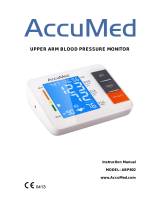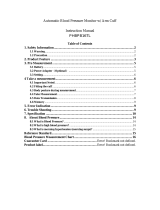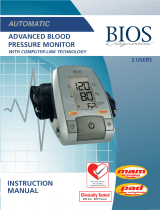Microlife CARDIO+ Owner's manual
- Category
- Blood pressure units
- Type
- Owner's manual
This manual is also suitable for
Microlife CARDIO+ is a reliable medical device for accurate blood pressure measurement, designed for use with your iPhone, iPad, or iPod touch. It comes with a preformed cuff, downloadable app, and easy-to-follow instructions. The app allows you to create user profiles, set blood pressure targets, save, view, and share measurement data. It also features a unique MAM (Microlife Average Mode) technology that takes and analyzes blood pressure in 3 successive measurements for a more reliable result. With Pulse Arrhythmia Detection (PAD) indicator, it alerts you to potential pulse irregularities.
Microlife CARDIO+ is a reliable medical device for accurate blood pressure measurement, designed for use with your iPhone, iPad, or iPod touch. It comes with a preformed cuff, downloadable app, and easy-to-follow instructions. The app allows you to create user profiles, set blood pressure targets, save, view, and share measurement data. It also features a unique MAM (Microlife Average Mode) technology that takes and analyzes blood pressure in 3 successive measurements for a more reliable result. With Pulse Arrhythmia Detection (PAD) indicator, it alerts you to potential pulse irregularities.




















-
 1
1
-
 2
2
-
 3
3
-
 4
4
-
 5
5
-
 6
6
-
 7
7
-
 8
8
-
 9
9
-
 10
10
-
 11
11
-
 12
12
-
 13
13
-
 14
14
-
 15
15
-
 16
16
-
 17
17
-
 18
18
-
 19
19
-
 20
20
-
 21
21
-
 22
22
-
 23
23
Microlife CARDIO+ Owner's manual
- Category
- Blood pressure units
- Type
- Owner's manual
- This manual is also suitable for
Microlife CARDIO+ is a reliable medical device for accurate blood pressure measurement, designed for use with your iPhone, iPad, or iPod touch. It comes with a preformed cuff, downloadable app, and easy-to-follow instructions. The app allows you to create user profiles, set blood pressure targets, save, view, and share measurement data. It also features a unique MAM (Microlife Average Mode) technology that takes and analyzes blood pressure in 3 successive measurements for a more reliable result. With Pulse Arrhythmia Detection (PAD) indicator, it alerts you to potential pulse irregularities.
Ask a question and I''ll find the answer in the document
Finding information in a document is now easier with AI
Related papers
-
Microlife BP A100 Plus User manual
-
Microlife BP A100 User manual
-
Microlife B2 Plus User manual
-
Microlife BP B1 Classic User manual
-
Microlife BP A3 Plus User manual
-
Microlife BP A3L Comfort User manual
-
Microlife BP3GX1-5A Owner's manual
-
Microlife BP3GU1-8X User manual
-
Microlife bp3gx1-5x Owner's manual
-
Microlife bp3gx1-5x User manual
Other documents
-
Sony SLV-N500 Installation guide
-
Aponorm Mobil Slim Owner's manual
-
CVS CVS 271244 User manual
-
 AccuMed ABP802 User manual
AccuMed ABP802 User manual
-
 PyleHealth PHBPB16TL Owner's manual
PyleHealth PHBPB16TL Owner's manual
-
LG 27HJ712C-W Owner's manual
-
CVS 800229 User manual
-
 BIOS Diagnostics BD850 User manual
BIOS Diagnostics BD850 User manual
-
CVS BP3MW1-4BCVS User manual
-
Medion Blood Pressure Monitor MD 15231 User manual

























